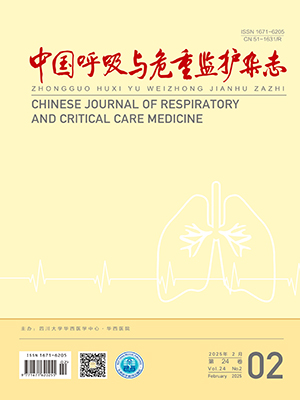| 1. |
Gloeckl R, Schneeberger T, Jarosch I, et al. Pulmonary rehabilitation and exercise training in chronic obstructive pulmonary disease. Dtsch Arztebl Int, 2018, 115(8): 117-123.
|
| 2. |
中华医学会呼吸病学分会慢性阻塞性肺疾病学组. 慢性阻塞性肺疾病诊治指南 (2013 年修订版). 中华结核和呼吸杂志, 2013, 36(4): 255-264.
|
| 3. |
Pirompanich P, Romsaiyut S. Use of diaphragm thickening fraction combined with rapid shallow breathing index for predicting success of weaning from mechanical ventilator in medical patients. J Intensive Care, 2018, 6: 6.
|
| 4. |
Mannino DM, Homa DM, Akinbami LJ, et al. Chronic obstructive pulmonary disease surveillance--United States, 1971-2000. MMWR Surveill Summ, 2002, 51(6): 1-16.
|
| 5. |
Celli BR, Cote CG, Matin JM, et al. The body-mass index, airflow obstruction, dyspnea and exercise capacity index in chronic obstructive pulmonary disease. N Engl J Med, 2004, 350(10): 1005-1012.
|
| 6. |
Kubincová A, Takáč P, Kendrová L, et al. The effect of pulmonary rehabilitation in mountain environment on exercise capacity and quality of life in patients with chronic obstructive pulmonary disease (COPD) and chronic bronchitis. Med Sci Monit, 2018, 24: 6375-6386.
|
| 7. |
Global strategy for the diagnosis, management, and prevention of chronic obstructive pulmonary disease (2006). [EB/OL]. [2017-02-21]. Available at: www.goldcopd.org.
|
| 8. |
Ries AL, Bauldoff GS, Carlin BW, et al. Pulmonary Rehabilitation: Joint ACCP/AACVPR Evidence-Based Clinical Practice Guidelines. Chest, 2007, 131(5 Suppl): 4S-42S.
|
| 9. |
Gea J, Pascual S, Casadevall C, et al. Muscle dysfunction in chronic obstructive pulmonary disease: update on causes and biological findings. J Thorac Dis, 2015, 7(10): E418-E438.
|
| 10. |
Osterling K, MacFadyen K, Gilbert R, et al. The effects of high intensity exercise during pulmonary rehabilitation on ventilatory parameters in people with moderate to severe stable COPD: a systematic review. Int J Chron Obstruct Pulmon Dis, 2014, 9: 1069-1078.
|
| 11. |
Kodric M, Trevisan R, Torregiani C, et al. Inspiratory muscle training for diaphragm dysfunction after cardiac surgery. J Thorac Cardiovasc Surg, 2013, 145(3): 819-823.
|
| 12. |
Mota S, Güell R, Barreiro E, et al. Clinical outcomes of expiratory muscle training in severe COPD patients. Respir Med, 2007, 101(3): 516-524.
|
| 13. |
Hellyer NJ, Andreas NM, Bernstetter AS, et al. Comparison of diaphragm thickness measurements among postures via ultrasound imaging. PM R, 2017, 9(1): 21-25.
|
| 14. |
Brown PI, Venables HK, Liu H, et al. Ventilatory muscle strength, diaphragm thickness and pulmonary function in world-class powerlifters. Eur J Appl Physiol, 2013, 113(11): 2849-2855.
|
| 15. |
Breland JY, Hundt NE, Barrera TL, et al. Identification of anxiety symptom clusters in patients with COPD: implications for assessment and treatment. Int J Behav Med, 2015, 22(5): 590-596.
|
| 16. |
Gupta B, Kant S, Mishra R, et al. Nutritional status of chronic obstructive pulmonary disease patients admitted in hospital with acute exacerbation. J Clin Med Res, 2010, 2(2): 68-74.
|
| 17. |
Lakhdar R, Rabinovich RA. Can muscle protein metabolism be specifically targeted by nutritional support and exercise training in chronic obstructive pulmonary disease?. J Thorac Dis, 2018, 10(Suppl 12): S1377-S1389.
|




